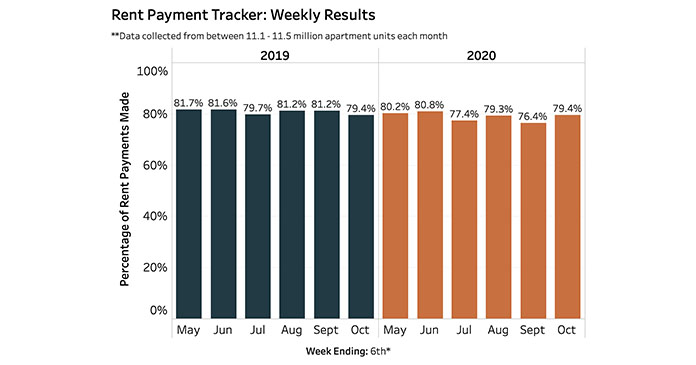The National Multifamily Housing Council (NMHC)’s Rent Payment Tracker found 79.4 percent of apartment households made a full or partial rent payment by October 6 in its survey of 11.4 million units of professionally managed apartment units across the country.
This is unchanged from the share who paid rent through October 6, 2019 and compares to 76.4 percent that had paid by September 6, 2020. These data encompass a wide variety of market-rate rental properties across the United States, which can vary by size, type and average rental price.
“Our initial findings for October show that despite ongoing efforts by apartment community owners and operators to help residents facing financial distress through creative and nuanced payment plans, rent relief and other approaches, renters and the broader multifamily industry are confronting growing challenges,” said Doug Bibby, NMHC President.
“As we have called for months now, leaders in both parties, in Congress and in the Trump administration need to step up, return to the negotiating table, and provide much-needed assistance and support to the tens of millions of Americans who call an apartment home. In light of the CDC’s nationwide eviction moratorium—a policy which will do nothing to deal with the long-term economic pain residents and housing providers are facing – policymakers need to act now to forestall the health and financial crises we are already grappling with from evolving into a housing crisis which would undermine the economic recovery and destabilize the country’s housing market.”
The NMHC Rent Payment Tracker metric provides insight into changes in resident rent payment behavior over the course of each month, and, as the dataset ages, between months. While the tracker is intended to serve as an indicator of resident financial challenges, it is also intended to track the recovery as well, including the effectiveness of government stimulus and subsidies.
However, noteworthy technical issues may make historical comparisons imprecise. For example, factors such as varying days of the week on which data are collected; individual companies’ differing payment collection policies; shelter-in-place orders’ effects on residents’ ability to deliver payments in person or by mail; the closure of leasing offices, which may delay operators’ payment processing; and other factors can affect how and when rent data is processed and recorded.
Find more information, including the methodology, on the NMHC Rent Payment Tracker.













